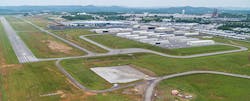Construction at Nashville's John C. Tune Airport Will Lengthen Runway, Upgrade Airport
John C. Tune Airport (JWN), located on the west side of Nashville, TN, is undergoing a $27 million dollar makeover that will include such upgrades as extending the single runway (2-20) 500 feet, full compliance with the specifications of FAA-mandated runway safety areas and a complete renovation of the terminal building.
The airport closed on June 1 to all but rotary-wing operations, and will reopen on July 31 with a newly paved, regraded, 6,000-foot runway, a full-length taxiway and new LED runway taxiway lights and signage. By November, additional enhancements in the form of a new instrument landing system and precision approach path indicator; new terminal area signage and landscaping; a rehabbed apron area and new concrete floors in 35 T-hangars will be complete.
Robert Ramsey, chief engineer of the Metropolitan Nashville Airport Authority (MNAA), which owns and manages John Tune Airport, together with Nashville International Airport (BNA), said the upgrades to the JWN runway include extension of the north-end runway safety area (RSA) to the required 1,000 feet, and the construction of a 400-foot Engineered Material Arresting System (EMAS) on the south end of the runway. EMAS, which has been installed at fewer than 100 airports, uses crushable materials that stop an aircraft that has overrun a runway, usually with little to no damage to the airplane. “FAA recommends the EMAS when the standard RSA is not possible,” said Ramsey, noting that a road and parkland prevent placement of a 1,000-foot RSA at the south end of Runway 2-20.
According to Ramsey, Airport Improvement Program grants from the FAA are paying for 90 percent of the runway and taxiway improvements, with the balance coming from state and MNAA funds. Construction crews are working 12-hour days, six days a week, and eight hours on Sundays, but Ramsey said that if the need arises, the pace would increase to 24/7 if necessary to ensure completion by July 31.
Allen Howell, CEO of Corporate Flight Management (CFM), the FBO at John Tune Airport, is looking forward to the airport makeover, despite the 60-day interruption to his business.
“It will be worth every bit of the nuisance,” said Howell, whose company has managed the FBO for 23 years and provides maintenance, charter and flight training services in addition to its role as an FBO. “It’s going to be a really beautiful and a first-class general aviation airport.”
Howell said that the renovations to the terminal and its exterior, which hasn’t been altered since it was built in 1986, will transform the building and its environs, providing an open and inviting look, larger conference facilities, a new reception area and more.
While JWN is closed, CFM has moved many of its aircraft and operations to Smyrna Airport (MQY), where it also operates an FBO, but Howell said he has “100 percent confidence” that MNAA will meet the construction deadline and get the runway back open on July 31.
“They understand the huge impact the closure has,” said Howell.
Greg Voos, NBAA's Southeast regional representative, credited MNAA for its vision and dedication in making the JWN upgrades happen. “With a 6,000-foot runway, John Tune will be accessible to most business aviation aircraft, which is great news for the Nashville area,” said Voos.
